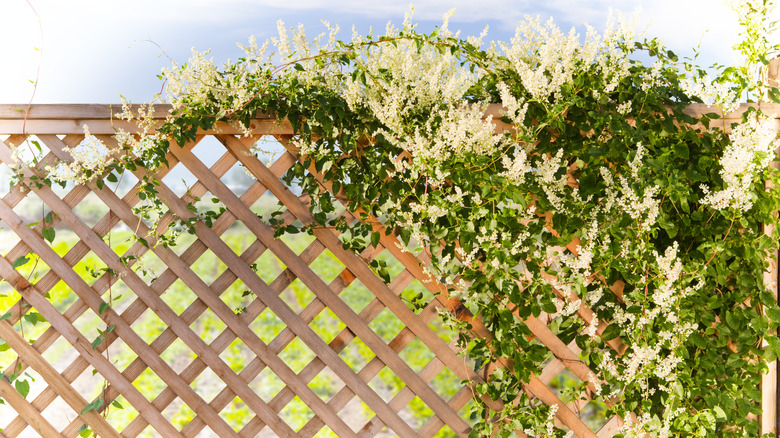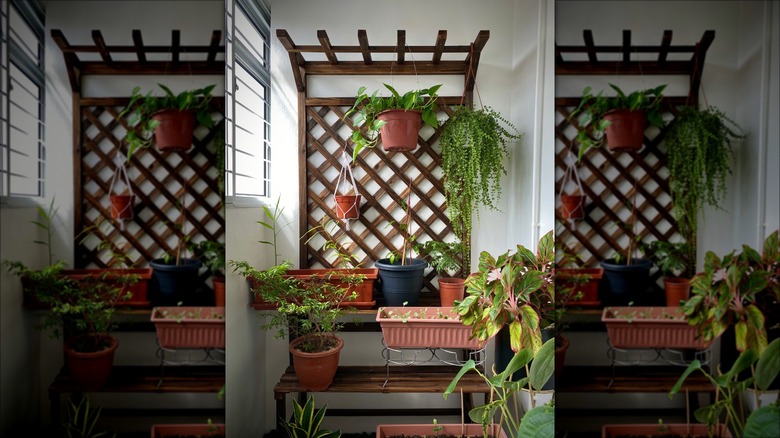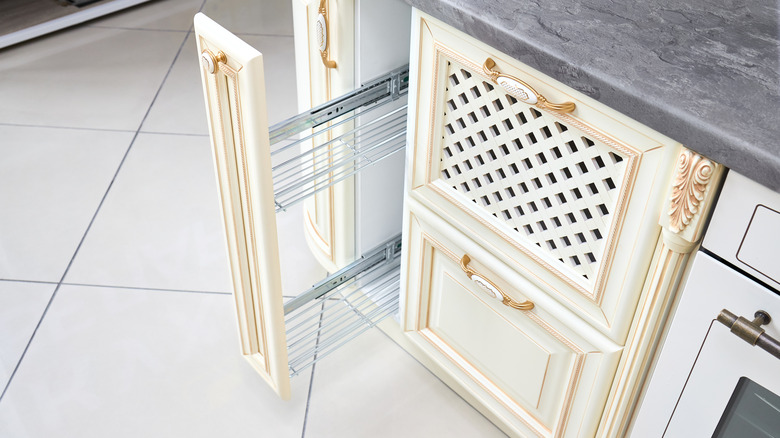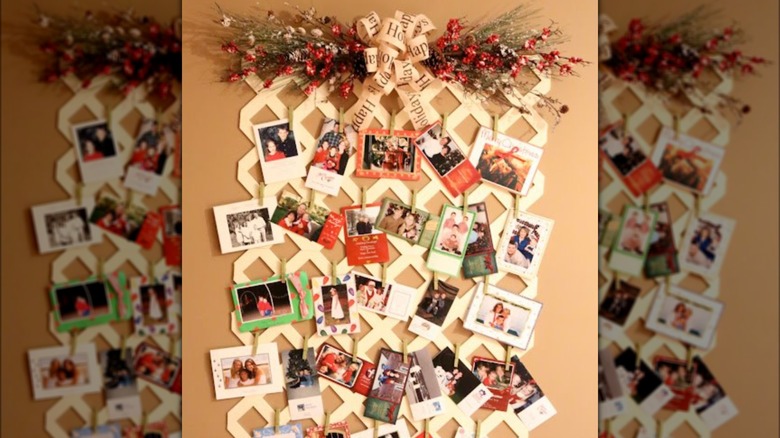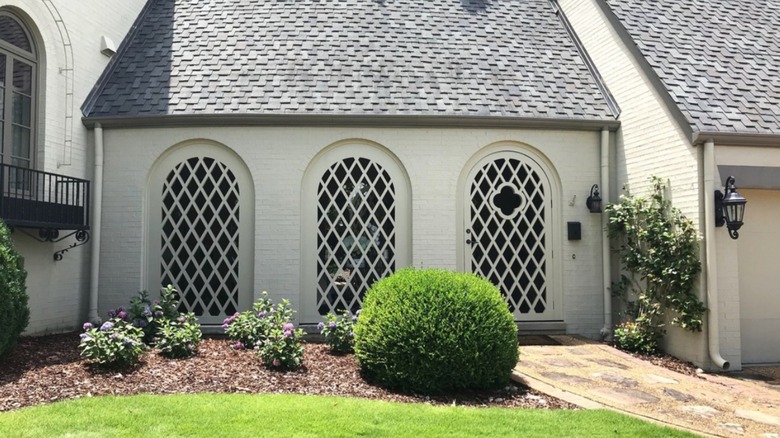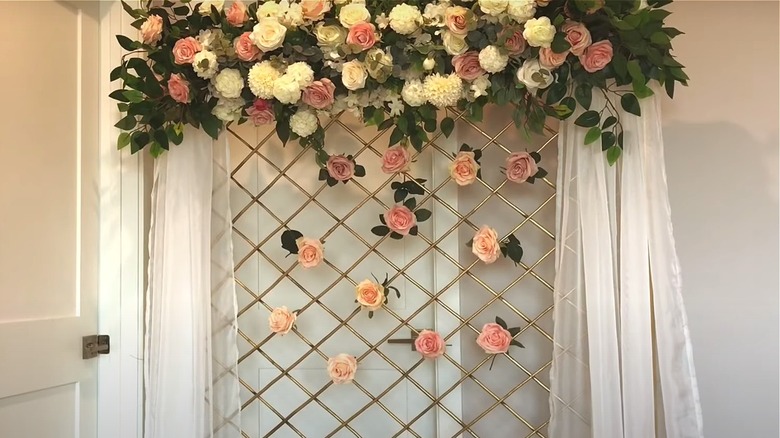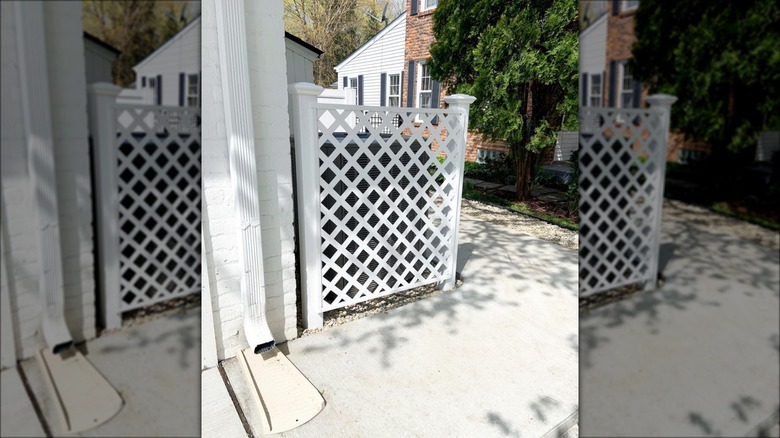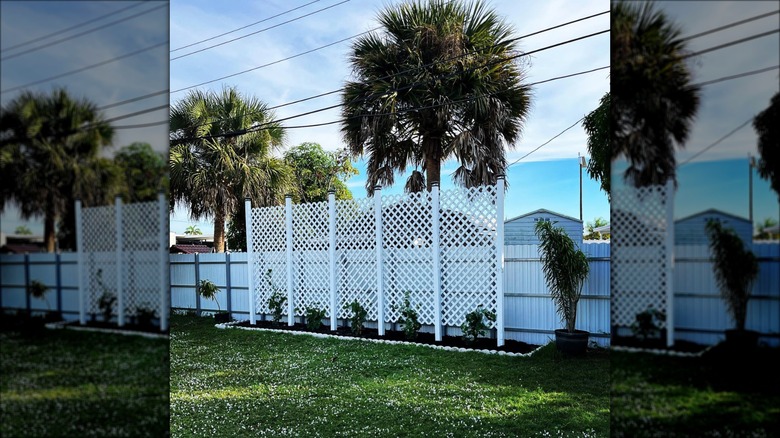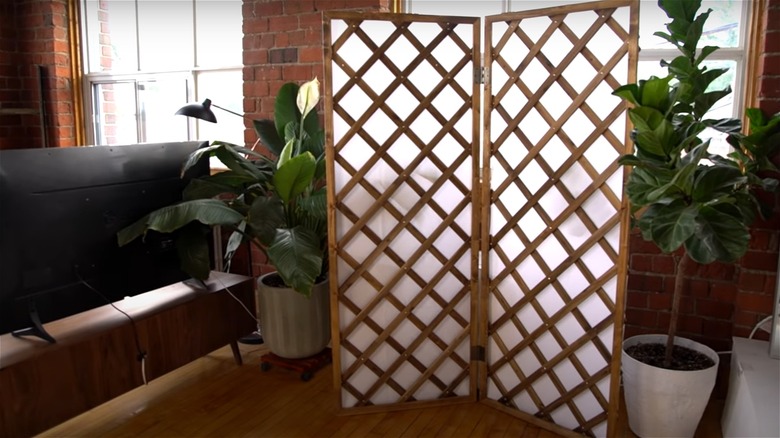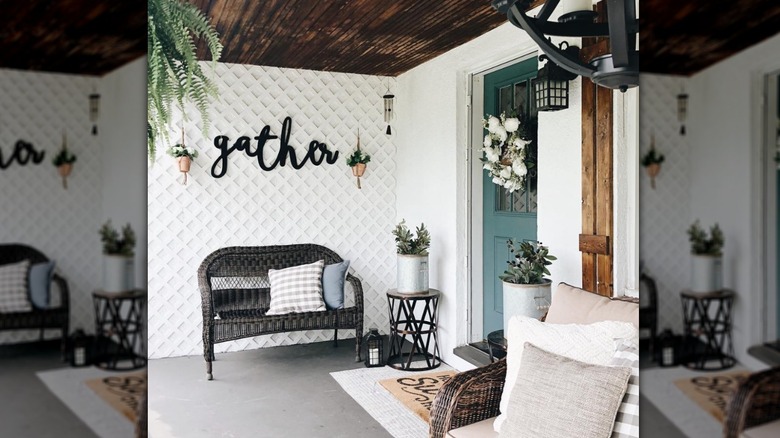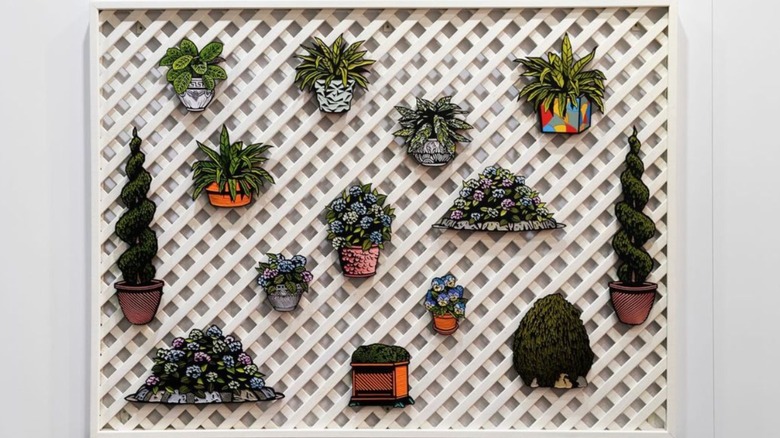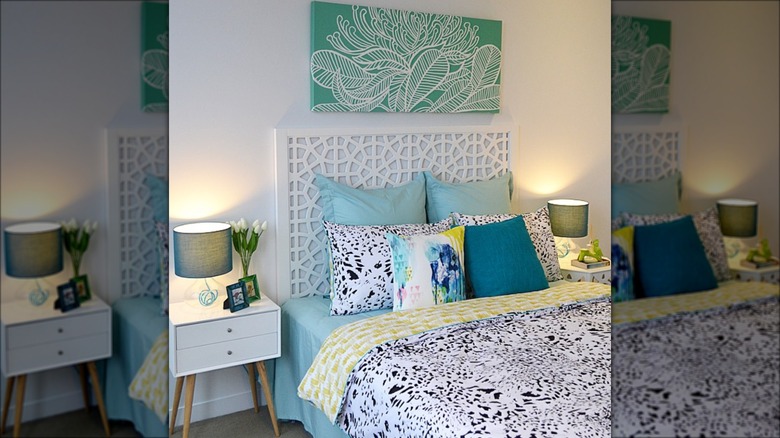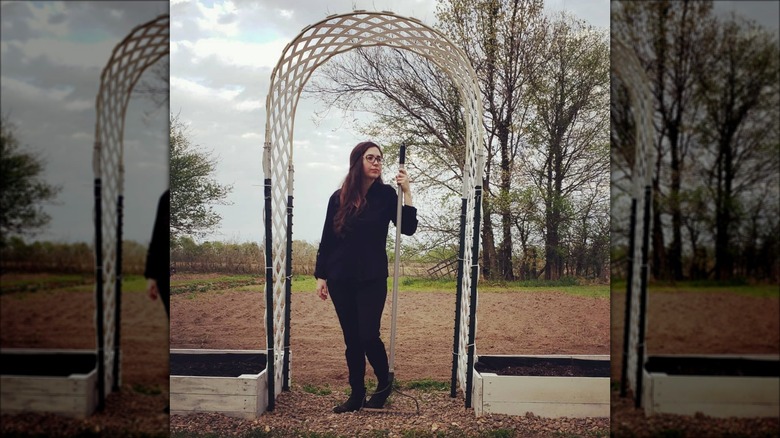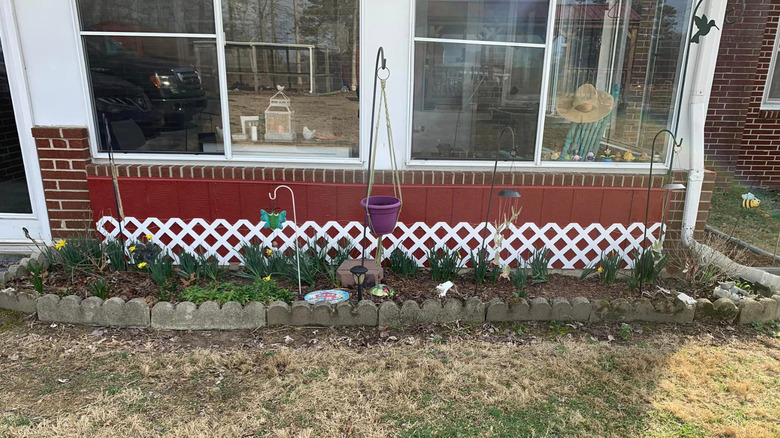Don't Throw Out Extra Lattice, Repurpose It In 13 Ways Around The House
Lattice is one of the most commonly-chosen fence and porch skirting materials thanks to its durability and classic look. Its simple, crosshatch-patterned design still allows air and sunlight to flow through, helping make your yard look larger and avoid the closed-off look of a more traditional fence. At the same time, it still acts as an effective divider and point of interest in an outdoor space. In some cases, it can even help to completely transform a yard, taking it from a bland patch of grass to something that more closely resembles an Italian vineyard or English garden.
With that being said, however, fencing or covering your porch railing aren't the only uses for lattice out there. If you find yourself with some extra material after a renovation, there are plenty of different locations these scrap pieces can come in handy, both inside the house and out in the yard. According to 2017 data from Statista, only about 21% of respondents said they regularly upcycled materials, despite the fact that doing so can both help to cut down on your waste and save you money in the long run. In a situation when you're left with extra materials, upcycling can be especially important as it allows you to repurpose items that would have otherwise gone straight from the store to the garbage. With a bit of creativity, you might even find that you like what you make even more than the alternative you would've purchased.
1. Gardening station
Lattice's unique crisscrossed design might be what gives it its decorative flair, but it can also help increase its functionality in a variety of different applications. This idea in particular is all about giving your hanging plants a place to rest. Add a piece of lattice to the back of a bench or small table, then use the crossed points as places to hang your plants on hooks. The tabletop will also give you a convenient home for your plants in regular planters, while any cabinets or open spaces on your gardening station can be used to hold supplies like gardening tools, soil, and seeds.
2. Cabinetry inlay
Lattice designs have quite a few functional purposes especially in the backyard, but they can be used for purely decorative reasons, too. If you're looking for a way to bring some texture and interest to a cabinet, whether you're upgrading boring kitchen storage or restoring a vintage piece, consider swapping the solid front panel for a piece of lattice. This DIY doesn't take a ton of material to pull off, so it's perfect if you only have a small amount of lattice left over, and the installed material can easily be painted to match the color or texture of your existing cabinet.
3. Card display
The holiday season is a time full of family and friends, and there's no better way to give yourself a reminder of their love than by displaying their cards. For many of us, however, the refrigerator quickly becomes cramped with photos, forcing us to find a better way to display them as the season continues on. This lattice card holder is the perfect simplistic solution, especially if you're in need of something low-profile. It can even be repurposed to display family photos, keepsakes, or children's art during the rest of the year simply by removing the seasonal decorations up top.
4. Window filler
Sometimes, glass just doesn't cut it. Whether you're searching for something to fill an open window frame in a shed, desire an item to add on top of existing glass for some more visual interest, or want a way to increase the airflow through an existing wall, a bit of lattice might be just what you need. Simply trim it to the shape of your window and nail it right into the frame. The final result will being some pattern and texture to what would have been an otherwise-simple area, and it might even help provide some protection for any glass you may have underneath.
5. Special event decoration
Floral and greenery displays can add freshness, beauty, and a pop of décor to just about any event, but relying on just vases or the occasional planter here and there often results in a lackluster look. If you want something that's more eye-catching, consider making a floral centerpiece out of some leftover lattice and scrap wood. After building a base that supports the lattice, weave vines and flowers through the holes to bring the look of a magical garden indoors. If you wanted to take it a step further, this centerpiece could also be used to display signage, show off photos, or hold seat assignment cards.
6. AC unit cover
During the warmer months of the year, our air conditioning units are our best friends, but that doesn't necessarily mean that we want them to be part of our backyard décor. AC units need to remain accessible and unobstructed to promote the free flow of air and allow for maintenance, so they're often just left as an eyesore sitting along the side of the house. This, however, doesn't have to be the case. If you have enough leftover lattice, you can easily build a small privacy fence to help obscure your air conditioner while still ensuring it functions properly.
7. Trellis wall
One of the most traditional uses for lattice, as well as one of the most beautiful, is to use it as a base for the climbing plants growing on your property. Some varieties of plants, from jasmine to tomatoes, have a tendency to wrap themselves around nearby structures. In many cases, this ends up being a wall, tree, or fence, but creating your own trellis out of lattice can give you more control over what your plants cling to and where they grow. To do this yourself, simply install some lattice directly into your plant bed. If it's stable, the plants should do the rest of the work.
8. Room divider
Open floor plans are fantastic for encouraging natural movement throughout the house, letting in as much natural light as possible, and ensuring a space feels bright and airy rather than dim and cramped. However, they can come along with some functional issues — namely the fact that it can be difficult to visually section off a large, open room. If you're looking for a solution to this problem, look no further than creating your own room divider. Combine some scrap lattice with a layer of fabric or shoji paper, then add some legs and supports or hinges between panels to create your own freestanding privacy screen.
9. Accent wall texture
Color is a fantastic way to bring more interest into a space, but relying purely on palette can result in a final look that falls flat. Instead, the best designs incorporate a combination of color and texture, bringing in both varying patterns and different materials to ensure the result feels dimensional. One of the more interesting ways to do this is through creating a lattice overlay accent wall that will liven up your home. When both elements are kept the same color, a lattice accent wall can provide a subtle pop of texture and pattern that doesn't detract from the rest of the space.
10. Wall art
If a full lattice wall is a bit too bold for your taste, consider sizing down your scrap piece into a backing for a piece of wall art. It might be a large departure from traditional canvas, but it can provide a great opportunity to play around with different textures and materials. Keep it plain and frame the edges for a more minimalistic accent, hang on photos with clothespins to personalize the final look, or use the lattice as a backing for another sign or piece of art that feels too small or disconnected from the rest of your décor on its own.
11. Textured headboard
Bedframes can get expensive, but if you already have a simple base and you're just looking to create the look of a headboard, there's no reason to shell out the big bucks. With a bit of clever placement, just about anything can serve the same purpose as a headboard — even some lattice that you have leftover from a garden makeover. To bring it from the backyard to the bedroom, measure out a piece that's the same width as your bed, then add some trim to the edges. Give everything a coat of paint if necessary, and it's ready to be hung on the wall behind your mattress.
12. Garden archway
When you have leftover supplies, you get the chance to play around with fun and creative décor pieces that you otherwise wouldn't have purchased because of your budget. A whimsical lattice archway is one such piece. If your lattice is flexible, this archway is incredibly simple to build — basically all you need to do is decide on how tall you want it to be, bend it, and then secure it into the ground with some stakes. From there, you can leave it as-is or plant some climbing plants nearby to eventually cover the surface and really sell the fairytale garden look.
13. Plant bed edging
Sometimes, garden beds have enough visual separation from the rest of the lawn simply because of the plants themselves or the mulch surrounding the area. In other cases, however, it can be helpful to create a barrier to help clean up this line and more clearly define the areas in your yard. There are plenty of different kinds of edging that will help do the job, from concrete barriers to more organic-looking stones, but a divider made of trimmed-down pieces of lattice fencing will both divide the space and create a cohesive look when the same material is used throughout the rest of your yard.
